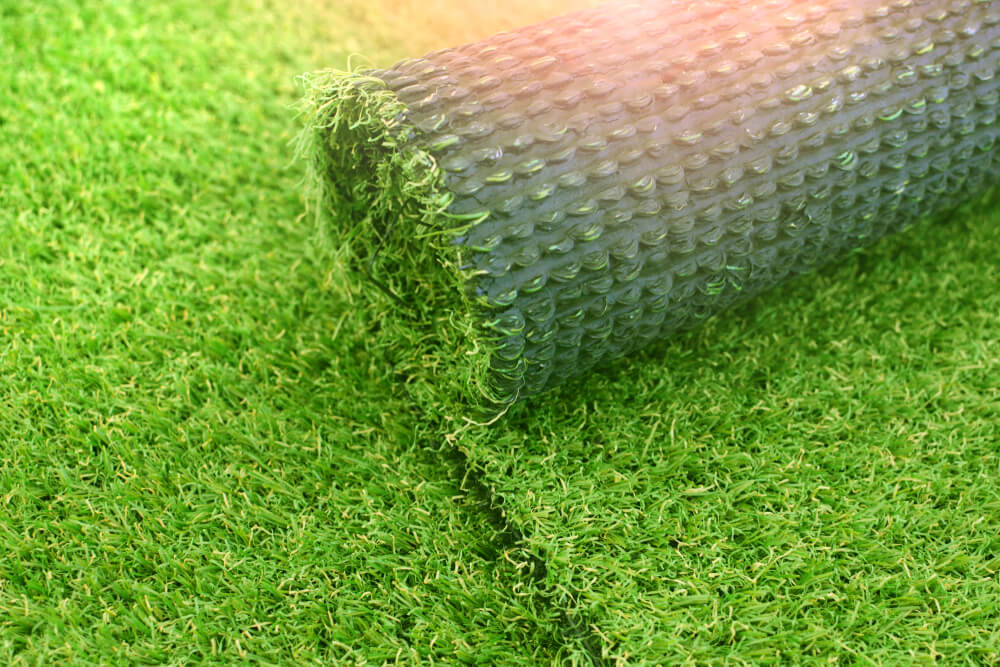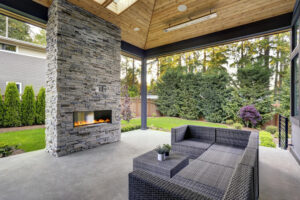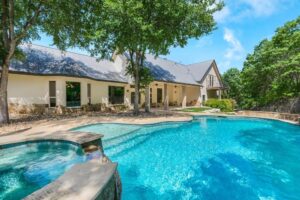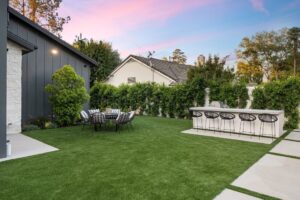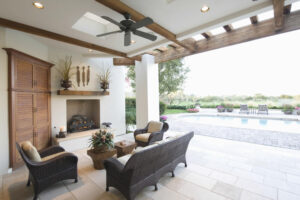Artificial turf grass first “hit the scene” in 1964 in Providence, R.I. high school, and was patented and invented by Monsanto. Back then, artificial turf was called ChemGrass, but it soon got reintroduced to the public as AstroTurf after the 1966 Houston Astrodome incident, when it was used to replace a natural burned-out grass field. As it caught on, more and more companies started producing artificial turf, and more and more high school and professional stadiums started to use it.
Still, how did artificial turf end up in residential yards? In this article, the expert team at Cricket Pavers will let you know the ins and outs of installing artificial turf, talk a bit about its history, and discuss artificial turf costs in general.
“Turfing The Yard” Did not Happen until The 1990s
Even though artificial turf grass was popular in stadiums, it wasn’t a “thing” for homeowners until the ’90s, when more decorative and less rugged options became available for the general public. And while it still isn’t the only way to go, it has been slowly gaining popularity among homeowners, with the New York Times reporting a 15% increase in installing artificial turf in residential homes since 2017.
Why did this happen? Some experts say that for long, artificial turf grass for yards looked way synthetic, and only a few years ago, modern versions managed to get to a degree where it’s almost impossible to tell the difference between an artificial turf installation and a well-kept and maintained lawn. To that end, some people who are otherwise die-hard fans of natural grass opt for artificial turf grass to help support their natural lawns.
Still, what to expect from artificial turf grass? They have their own set of advantages and possible drawbacks, and if you are looking for artificial grass installation tips, you are aware of them both. That said, here are a few valuable tips that will help you get the most out of the process of turfing the yard.

Infil and Turf: Choose Based on Expected Use
Artificial turf is crafted from materials like nylon, polyethylene, and/or polypropylene. While offering a soft and realistic feel, nylon tends to be less durable. On the other hand, polypropylene excels in durability but may not match realism. Polyethylene balances the two and stands out as an ideal choice, particularly if you have pets, given its ease of cleaning and deodorizing.
Consider the pile height when selecting artificial turf. Optimal pile heights range from two to three inches, ideal for high-traffic areas. This height enhances durability and provides a comfortable surface for walking and playing. For lower-traffic spaces like courtyards or apartment balconies, shorter pile heights ranging from 1/2 to 1 1/2 inches are more manageable and easier to maintain.
Infill, the material applied to the turf after installation, anchors it and mitigates heat retention in the synthetic grass blades. While crumb rubber, derived from recycled car tires, is a common infill, it has drawbacks. It’s lightweight, susceptible to displacement in high winds, and can amplify artificial odors.
Additionally, it raises environmental concerns due to potentially leaching toxic chemicals into the ground.
A safer choice for infill includes acrylic-coated sand and silica sand. Zeolite, another eco-friendly alternative, not only addresses environmental concerns but also boasts deodorizing properties that can be particularly beneficial for households with pets. Making informed choices in these aspects ensures that your artificial turf meets your needs and preferences effectively.
Safely Eliminate Existing Grass
If installing artificial turf, in your case, will also involve replacing an existing lawn, you need to make sure that the grass is dead in the entire area. The safest way to ensure that you start with a clean slate on the area is by solarizing it. This simple process usually involves covering the area with black plastic and letting the sun do its thing: bake the grass to death, eliminating any growing weeds in the process. This can be a lengthier process, as it may take a few months, but if you are up to the task and want the artificial turf installation finished faster, you can also opt for digging out the grass.
If you opt for the latter, ensure that you remove a minimum of four inches of soil from the top to catch all the roots. Be ready, as there will be a massive amount of dirt, and you must also manage disposal.
Choosing a Good Substrate
While artificial turf grass can be installed directly into the ground, it won’t look like a well-kept lawn as the small depressions and bumps will be painstakingly visible and often distracting. So, to avoid this, experts usually recommend installing at least four inches of class two reload base rock as a substrate (or something similar), then compacting that to the solid surface.
After the base rock, using a half to one-inch layer of decomposed granite or sand can also be optimal for providing a smooth turf underlay. Still, if you want to avoid digging that deep, you may opt for a simple layer of decomposed granite, or complicated sand may offer good drainage, comfort, and solidity.
Level and flatten the surface as you proceed with the installation. Ensure that the flat sections of your newly laid artificial turf lawn maintain a minimum slope of 1/4 inch per foot toward a designated runoff area. This slope is crucial for preventing water accumulation under the turf, which could lead to its deterioration.
The Blade Direction Should Remain Uniform
Artificial turf grass comes in rolls, just like carpeting. The rolls are usually heavy and will usually require at least two people to manage. This means that you will need help lugging the rolls around and positioning them. Once you get a roll to the designated area, leave it in the sun for at least an hour before you unroll it. This will ensure that the roll will lay out flatter and be more pliable.
Also, when putting two turf sections side by side to cover a wider area, don’t forget to check whether the blades of both rolls should be facing the same direction. If they are opposite ends, the new lawn will look more like a patchwork than a unified lawn.
The Edges Should Be Cut Slightly Long
Also, when you have laid out the turf, you will have to trim the edges, like in the case of carpeting, to match the perimeter of the given room. You don’t need anything fancy; a really sharp utility knife should do this, and don’t forget to always cut from the back.
When doing this, leave a few extra inches there so you can tuck some of the material against your walkways or under borders. It’s better to leave a bit too much at first, as it’s easier to remedy than leaving too much and seeing gaps that are difficult to hide.
When you’re done, take the edges and secure them with landscape nails or staples.

Spread and Brush The Infill
You can use a simple drop spreader for this. Simply pick a type of infill and apply the quantity that the artificial grass manufacturer recommends. Once applied, brush the infill into the turf with a push broom with hard bristles and follow the direction of the blades.
Talking About Artificial Turf Costs
Artificial turf costs will vary, depending on brand and material. Nylon will be the least durable (but the softest) and will cost around $5.05 to $5.85 for a square foot. Polypropylene offers a wide selection (with turf costs ranging from $1.90 to $6.75 per square foot), and polyethylene is set somewhere in the middle, with costs ranging between $2.55 and $3.85.
Let The Pros Do Their Work
Artificial turf costs will be slightly higher if you opt for professional installation. Still, labor costs are often well worth the extra, as experienced professionals know how to tailor to every need and will make the end result look striking and realistic. Also, apart from professional workmanship, you will often be offered great promotions and decade-long (if not more) warranties.
If you want the best in town to take care of your turf, feel free to reach out today.
